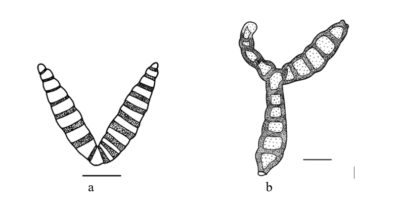Fungalpedia – Note 160, Ceratohirudispora (Fossil fungi)
Ceratohirudispora R. Kar, Mand. & R.K. Kar.
Citation when using this data: Saxena RK & Hyde KD. 2024 (in prep) – Fungalpedia, Fossil Fungi.
Index Fungorum, Facesoffungi, MycoBank, GenBank, Fig. 1
Classification: Phragmosporae, Fungi.
Kar et al. (2010) introduced Ceratohirudispora from the Bhuban Formation (Early Miocene, 23–16 mya) of Tlangsam, Mizoram, India. This genus is characterized by the following diagnosis: Hyphomycetaceous fungi with small conidiophore, growth terminated by the production of apical conidium. The conidium enlarges laterally in opposite direction to produce two–three arms. Conidia are 5–10 celled, with septa up to 2 μm thick, with a broad base and narrow tip. The conidia of C. miocenica Kar et al. 2010 (Type) is two-armed and V-shaped (Fig. 1a), while the C. triradiata Kar et al. 2010 is three-armed and triradiate (Fig. 1b). Two species are included in Index Fungorum (2023) under this genus.
Type species: Ceratohirudispora miocenica R. Kar, Mand. & R.K. Kar.
Figure 1 – a Ceratohirudispora miocenica. b Ceratohirudispora triradiata. Scale bar: a, b = 10 μm. Redrawn from Kar et al. (2010).
References
Entry by
Ramesh K. Saxena, Birbal Sahni Institute of Palaeosciences, Lucknow, India
(Edited by Kevin D. Hyde, Samanaeh Chaharmiri-Dokhaharani, & Achala R. Rathnayaka)
Published online 26 October 2023
